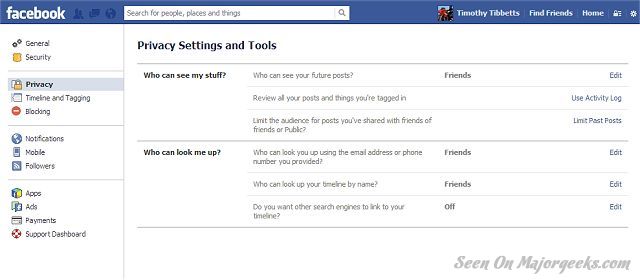News stories whining about Facebook - I call BS
Posted by: Tim Tibbetts on 06/04/2013 07:13 AM
[
 Comments
]
Comments
]
I have noticed something lately. News stories complaining about the way things work with Facebook now. The problem is that these stories just complain and do little to help solve the problem.
 Let’s take the DailyDot, although hundreds of examples exist. Today, Kevin Morris wrote a long post about how horrible Facebook is now. He complains about the ads (or featured posts) found on Facebook and even wrote a misleading title called The great defriending of Facebook.
Let’s take the DailyDot, although hundreds of examples exist. Today, Kevin Morris wrote a long post about how horrible Facebook is now. He complains about the ads (or featured posts) found on Facebook and even wrote a misleading title called The great defriending of Facebook.
Also, just yesterday I spotted a news story in a technology section by someone who said they deleted their account after someone posted a picture of their newborn, not cleaned yet, baby.
I call BS.
To read the article about the so called great defriending of Facebook I first had to scroll past a HUGE advertisement for Heineken, complete with video. Alongside that was the usual Facebook, Twitter and Tumblr sidebar so that you can like or share the story, which is exactly what they are complaining about. In the case of Daily Dot, they had a second social sidebar to the left as well. At the bottom of their page more and more images to other stories with advertising between every few sections continues to load, seemingly forever. I scrolled and finally stopped after I counted 60 images with links to their other stories. I assume Mr. Morris has no control over this, and he meant everything he wrote, but you can’t miss the irony of someone complaining about social media and advertisements in a news story literally surrounded on all sides by advertisements and social media links.
Don’t get me wrong; in many ways I agree with Mr. Morris. My issue is that these so called stories do nothing to solve the problem. They are designed to attract traffic to their story and hopefully show advertisements and attract people to their social media pages. If you get lucky, the story gets shared a lot and you get a lot of comments. I have always maintained for my 20 years of web publishing that the internet parallels real life. The biggest difference has always been that anyone can start a website really cheap (or free) but as you grow you need to figure out how to pay the bills, and then become profitable. Most people fail at the paying the bills point, never getting to the profit part. There lies the problem and the Facebook complaints. They went from free, to paying the bills to one of the largest companies in the world. Now they have stockholders to answer to.
The majority of people don’t know, nor care what to do about it. They simply just use their favorite websites and social media and go about their day. Settings exist to personalize your experience but Facebook has always buried these settings.

I still love Facebook, but there’s a reason. I believe that for personal use I use it as intended. Most people spend hours on Facebook every day. If you spend that sort of time then you should modify your settings. Look for the padlock and gear in the top right corner (it’s small) and go to your settings. Go through everything. Remove apps, modify notifications and decide who sees what and much more. How many friends do you have? No, really? I have exactly 100 and I know all of them. At the risk of being offensive to some, if you have hundreds of friends then you really have no reason to complain. No one has hundreds of real friends.
Another thing constantly missed is a simple way to determine what you see in your news feed individually. Let’s say someone keeps sharing photos and you’re not interested in seeing that. Look for the really subtle, gray arrow to the top right corner of any post. On your computer you need to line your mouse over the post. Click that and select ”hide”. Now you get options on what and when you see posts from that person.

As the Daily Dot points out, the bonds with your friends are becoming overwhelmed with posts from strangers. Using the methods mentioned above, I don’t have that problem. I do agree there are more ads and featured posts than ever before but you can still make your Facebook page more usable with as little effort as it takes to click that share link.
 Let’s take the DailyDot, although hundreds of examples exist. Today, Kevin Morris wrote a long post about how horrible Facebook is now. He complains about the ads (or featured posts) found on Facebook and even wrote a misleading title called The great defriending of Facebook.
Let’s take the DailyDot, although hundreds of examples exist. Today, Kevin Morris wrote a long post about how horrible Facebook is now. He complains about the ads (or featured posts) found on Facebook and even wrote a misleading title called The great defriending of Facebook. Also, just yesterday I spotted a news story in a technology section by someone who said they deleted their account after someone posted a picture of their newborn, not cleaned yet, baby.
I call BS.
To read the article about the so called great defriending of Facebook I first had to scroll past a HUGE advertisement for Heineken, complete with video. Alongside that was the usual Facebook, Twitter and Tumblr sidebar so that you can like or share the story, which is exactly what they are complaining about. In the case of Daily Dot, they had a second social sidebar to the left as well. At the bottom of their page more and more images to other stories with advertising between every few sections continues to load, seemingly forever. I scrolled and finally stopped after I counted 60 images with links to their other stories. I assume Mr. Morris has no control over this, and he meant everything he wrote, but you can’t miss the irony of someone complaining about social media and advertisements in a news story literally surrounded on all sides by advertisements and social media links.
Don’t get me wrong; in many ways I agree with Mr. Morris. My issue is that these so called stories do nothing to solve the problem. They are designed to attract traffic to their story and hopefully show advertisements and attract people to their social media pages. If you get lucky, the story gets shared a lot and you get a lot of comments. I have always maintained for my 20 years of web publishing that the internet parallels real life. The biggest difference has always been that anyone can start a website really cheap (or free) but as you grow you need to figure out how to pay the bills, and then become profitable. Most people fail at the paying the bills point, never getting to the profit part. There lies the problem and the Facebook complaints. They went from free, to paying the bills to one of the largest companies in the world. Now they have stockholders to answer to.
The majority of people don’t know, nor care what to do about it. They simply just use their favorite websites and social media and go about their day. Settings exist to personalize your experience but Facebook has always buried these settings.

I still love Facebook, but there’s a reason. I believe that for personal use I use it as intended. Most people spend hours on Facebook every day. If you spend that sort of time then you should modify your settings. Look for the padlock and gear in the top right corner (it’s small) and go to your settings. Go through everything. Remove apps, modify notifications and decide who sees what and much more. How many friends do you have? No, really? I have exactly 100 and I know all of them. At the risk of being offensive to some, if you have hundreds of friends then you really have no reason to complain. No one has hundreds of real friends.
Another thing constantly missed is a simple way to determine what you see in your news feed individually. Let’s say someone keeps sharing photos and you’re not interested in seeing that. Look for the really subtle, gray arrow to the top right corner of any post. On your computer you need to line your mouse over the post. Click that and select ”hide”. Now you get options on what and when you see posts from that person.

As the Daily Dot points out, the bonds with your friends are becoming overwhelmed with posts from strangers. Using the methods mentioned above, I don’t have that problem. I do agree there are more ads and featured posts than ever before but you can still make your Facebook page more usable with as little effort as it takes to click that share link.
Comments






